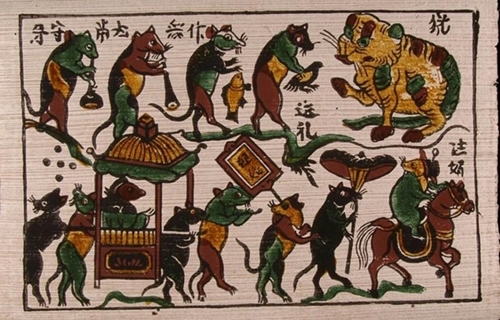In the past, Dong Ho paintings were used as decorations at homes in the Red River Delta during the lunar New Year festival (Tet). Hanging a Dong Ho painting in the house at the beginning of a new year was believed to bring happiness and prosperity for the family. The folk paintings have become part of Vietnamese life through generations and are now used in the modern arts, including painting, sculpture, fashion, and pottery.
    |
 |
|
Rats' Wedding, a famous painting of the Dong Ho folk woodcut painting genre |
Dong Ho painting is special because it is printed by hand entirely from woodblocks. Each painting has one woodblock for the outline and several others for printing colors. The number of the woodcuts corresponds to the number of colors a painting has. The colors of paint are processed from natural materials Vietnam. The woodblocks are engraved by hand and can be kept for many years.
Dong Ho paintings are printed on "do" paper made from "do" tree bark and covered with a layer of scallop shell powder mixed with sticky rice paste. The scallop seashell gives a sparkling white background while the rice paste makes the paper more supple and able to maintain colours for a long time. To print a painting, the woodblock is applied with paint and pressed on a sheet of paper. The process is repeated for each colour and the finished picture is the result of joining different colours in a certain order.
Dong Ho paintings feature the life of northern delta inhabitants. The themes vary, from familiar livestock such as buffaloes, pigs and chickens, to daily activities, historical figures, cultural values, folk allegories and social commentaries. Typical Dong Ho paintings include Vinh Hoa and Phu Quy (Eminence and Prosperity), Corpulent Pig with Piglets, Hen Surrounded by Chicks, Rat’s Wedding, Scene of Jealousy, Scene of Wrestling, Scene of Catching Coconuts, Saint Giong, Ngo Quyen, and Trung Sisters.
In 1945, Dong Ho village had 17 families making Dong Ho paintings. Now, only two families of artisans Nguyen Huu Sam and Nguyen Dang Che still do the craft. The two families have conserved over 1,000 woodblocks and restored 500 ancient woodcuts.
In recent years, Dong Ho paintings have regained popularity due to a rising demand from foreign tourists. This has largely encouraged local artisans to revive and develop the craft.
In Song Ho commune, there is a center for Dong Ho painting conservation located inside the workshop of Nguyen Dang Che’s family. The center has a showroom displaying thousands of paintings and a workshop where artisans show visitors how the paintings are made.
Source: VNA